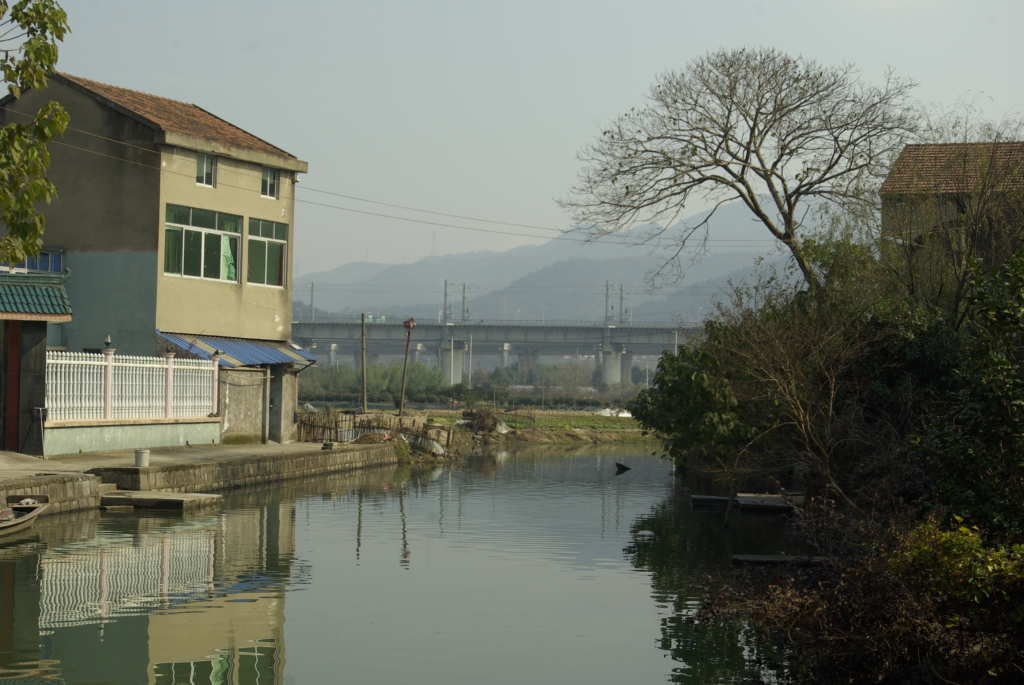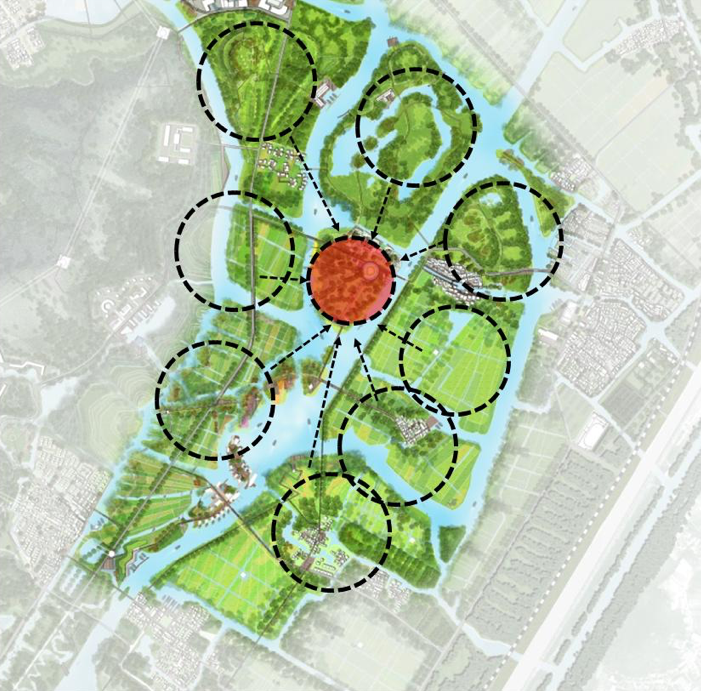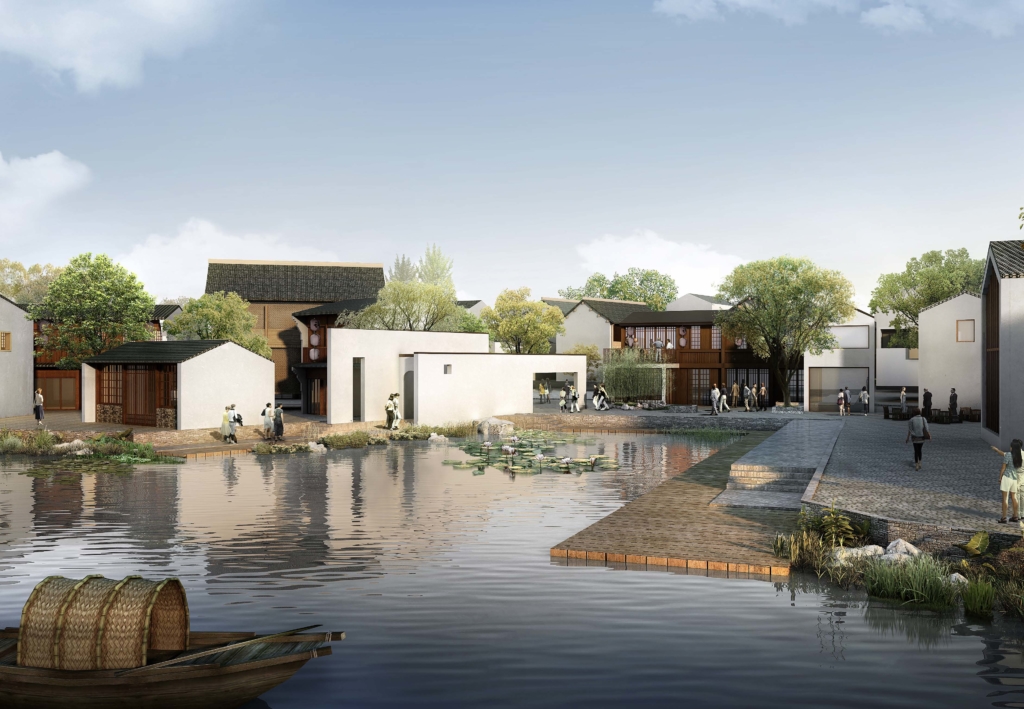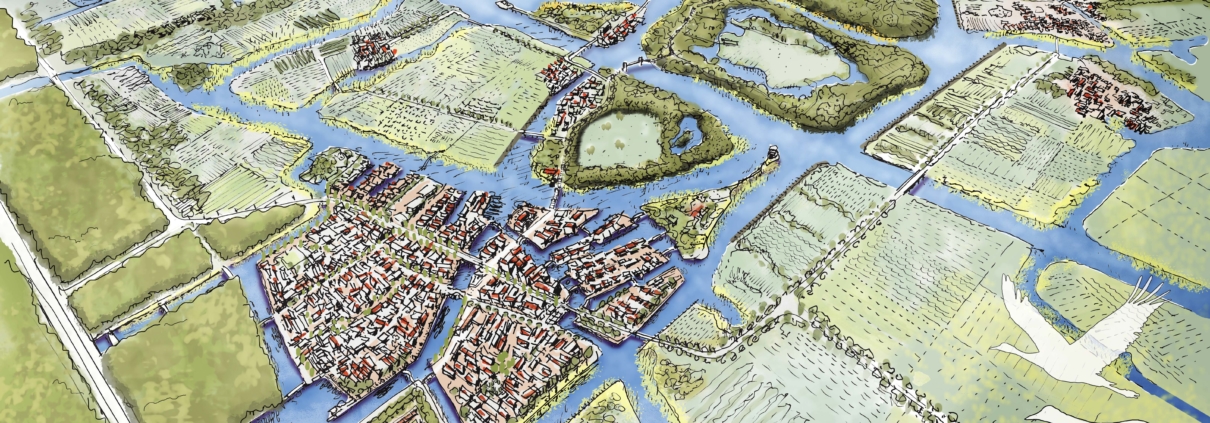Prijs voor groenblauwe strategie in Ningbo, China
In 2015 ben ik door de Ningbo Urban Planning Bureau and Design Institute en de Ningbo Urban Planning Bureau gevraagd om een team met Nederlandse experts en ontwerpers samen te stellen voor een bijzondere opgave: het maken van een ruimtelijke ontwikkelingsstrategie voor de Xiaojia River District. Dit is een landelijk en waterrijk gebied gelegen tussen verstedelijkte gebieden aan de rand van Ningbo. Het team bestond uit Mark Niesten en Wouter Vos (KuiperCompagnons), Rob van der Wijst (Next Level Urban Design), Hans Hofman (Buro Hofsteden) en Sébastien Goethals (Citylinks). Dit plan is in 2017 bekroond met de First Prize Excellent Planning Award van de Society of Urban en Rural Planning of Zhejiang Province. De stad van Ningbo was hier heel blij mee omdat deze jaarlijks prijs doorgaans wordt binnengehaald door de Hangzhou, de hoofdstad van Zhejiang Province. De ruimtelijke ontwikkelingsstrategie heb ik met Zhe Chen, Zhang Nenggong, Mindong Ni en Weimin Zuo samengevat in het onderstaande artikel voor de ISOCARP Review 13 Smart Communities.

Ecological Restoration and Urban Renovation in Ningbo’s Xiaojia River District
To live in the countryside with nature has always been an important theme in Chinese culture. Villages in the countryside were long regarded as cultural seeds; a refuge where intellectuals, poets, philosophers, and scholars, like Du Fu, could retreat away from the busy cities. The rural world in China was the firm basis for civilised poetic life, governed by tradition and social harmony. The rural world respected nature but also was the economic base of the cities. Despite their importance, during China’s long and turbulent history rural communities were disturbed by wars and conflicts between cities, dynasties, and ideologies. But over the ages, rural traditions proved to be resilient, and harmony always returned in the countryside and the villages of China. Now in the last decades, the fast economic development and rapid urbanization of China has caused the countryside and the villages to become abandoned. Life in the cities provides more chances for higher education, better jobs, and better living circumstances.
The Xiaojia River District is one of the areas near Ningbo where the essence of the countryside and life in villages still exists. There the way of life, synonymous with social harmony, respect for nature and observance of traditional ways, can be maintained for the present and future generations of inhabitants of Ningbo. The Ningbo Urban Planning and Design Institute and the Ningbo Urban Planning Bureau joined forces with KuiperCompagnons and the Connecting Cities Network to make a spatial development strategy for the Xiaojia River District. This strategy has ideals and ideas that are valid and important for the future Ningbo and may serve as a reference for other cities in China.

About Ningbo
Ningbo is a coastal city located in southeast China. Modern Ningbo includes the historic city, three new satellite cities and several adjacent counties. This area has Shanghai on the north, Hangzhou on the west, Taizhou on the south and East China Sea on the east. Lying in the east of Zhejiang province, Ningbo sits at the mid-point of the Chinese coastline, towards the south of the Yangtze Delta. Ningbo lies between the ocean and low-lying mountains to the southwest with coastal plain and valleys in between. Water, mountains, fields, and villages are the basic components of the region.
The historic city of Ningbo is one of China’s oldest cities. Its history dates to the Neolithic Hemudu Culture (5500 – 3300 B.C.). Ningbo’s historic city and urban core is centred on the confluence of the Yong and Yuyao Rivers. Located along the eastern coast of the country, it developed as a port and maritime trading centre. Like many other Chinese cities, it has experienced rapid urbanization and urban expansion resulting from the creation of development zones established in the 1980s and 1990s. The city now has a population of 7.6 million and spans over an area of 9.816 square kilometres. Ningbo’s GDP reached 854 billion Yuan (128 billion USD) in 2016 and ranked as the 16th city in China. The manufacturing and services industries are the two major components of modern Ningbo’s economy.
Like other cities that experienced rapidly development, Ningbo’s growth had negative effects such as the encroachment of urban ecological space, a relatively low level of urban quality, and lack of urban identity. In addition, Ningbo’s previous development concepts left a noticeable number of unaddressed issues regarding ecological environmental protection, infrastructure construction, and urban quality formation. In recent decades, the booming Ningbo economy has resulted in rapid industrialization and urbanization. Besides economic growth and an increase of wealth and prosperity, this fast urbanization also resulted in challenges to the goal to create a liveable and loveable environment for Ningbo citizens. To realize this Chinese dream, Ningbo must secure a green and liveable urban environment where future generations can find a healthy, educational, and recreational environment that is close to nature.
The challenges in combining urban development with ecological conservation are not new to the city of Ningbo. In 2014, Ningbo was one of the laureates of the ISOCARP Awards for Excellence for a well-balanced and innovative regional plan to develop the Xiangshan Harbor, while protecting the biodiversity of the vulnerable marine environment and combining this with modern fishery and coastal tourism. More recently, Ningbo has been appointed as a national experimental city for ecological restoration and urban renovation. In particular, it has been designed to combine urban planning, landscape design and water management to enhance flood safety and water resilience to improve the living environments and wellbeing of the citizens of Ningbo. Over the next 3 years, Ningbo will receive financial support of approximately 60 million USD for so called ‘Sponge City’ developments and projects, which were introduced to respond to ‘China’s New Normal’ policy. These projects will become a showcase for thousands of towns and urban developments in China. The experiences of these projects are now inseparable elements of the new Master Plan that aims to make Ningbo a more attractive, competitive, liveable, and sustainable city in the decades to come.

Xiaojia River District
The Xiaojia River District is a very special area in Ningbo. It is one of the remaining large green areas close to the centre of the city, where millions of people live, work, and recreate. In comparison with the hectic and busy city centre, the Xiaojia River District can be characterized as a green oasis where the speed of life slows down. The area has a rich history and large cultural heritage. The attractive green landscapes are dominated by small-scale farmlands, forested mountains, dense water networks and scattered small villages. Three quarters of the total site is undeveloped. The area has an intensive water network, which makes up 12% of the Xiaojia River site surface and 16% of the core Xiaojia River site surface. The site is surrounded by mountainous land on the east periphery. There are three hills inside the Xiaojia River site, the 140m high Long Mountain in the southwest side and two small mounts in the centre. The Long Mountain is seriously damaged with 9 quarries on both sides where building materials were excavated.
Despite the many potentials and opportunities for Xiaojia River District, it also faces upcoming urbanization, an aging population and shrinking villages. A strong new perspective for the area is required. This article describes a development strategy that offers new perspective and aims to protect the environmental and cultural heritage and simultaneously improves the socio-economic position of the area. This strategy builds upon the existing unique identity, and aims to secure a long term integrated development of the area, to make it attractive for visitors and citizens of Ningbo, and for the local population. The strategy has the ambition to protect the natural, ecological, spatial, social, cultural, and economic values of the Xiaojia River District. This is to be achieved by delicately addressing these values simultaneously in an integrated manner, guided by five ambitions. The ambitions are: to use water as the spirit of the area; to protect ecology by development and activation; to create new socio-economic perspectives for the villages; to integrate touristic, iconic, recreational and leisure functions; and lastly, to provide and infrastructure for low carbon mobility.

Ecological Restoration and Urban Renovation Act
In 2016, the Central Economic Working Conference of the Chinese Government adopted the strategy to strengthen urban and rural planning and design, to restore natural and ecological vital areas and to encourage renovating urban areas. This new policy, developed by the Ministry of Housing and Urban Rural Development (MOHURD), marks the beginning of a new phase in China’s urban-rural planning and reconstruction. The Ecological Restoration and Urban Renovation Act emphasises the need for nation-wide tasks and targets on a local and city level. In effect, MOHURD directs regional and local governments to retrofit and redevelop cities to improve the quality of life for citizens. This works in two steps. First, the regional and local governments set minimum standards to prevent harm from development in ecological areas by guiding urban development in reasonable and responsible ways. Secondly, the planning policies of these governments need to focus on improving the quality and efficiency of developments in built urban areas and need to pay special attention to promote an improved living environment.
Ecological Restoration and Urban Renovation are a transition in both the urban development policy as well as the administrative of urban governance. Ecological restoration encourages the repair of damaged natural features and the enhancement of ecological qualities and landscapes. It also emphasises the relationship between urban and ecology, between protection and development, and between human and nature. Urban Renovation, on the other hand, aims to upgrade urban functions and infrastructure and to improve urban identity and vitality through organic urban renewal. The planning and urban design of the Xiaojia River District is an important component of the Ecological and Urban Redevelopment Act project. National and local governments support these projects to create a high-quality result over a long period of time. Introducing the Xiaojia River planning and urban design project and piloting the development in an ecological controlled area is done to create a strong local identity and an improved urban vitality. Presently, the governments are adopting new roles and are guiding development proactively rather than controlling and protecting passively. The ambition for the Xiaojia River District is to effectively protect ecological areas from urban expansion, to improve the conservation of natural habitats as well as cultural heritage, and to utilize the resources in the ecological areas and to uplift other potential spatial, social, cultural, and economic values.

Balance between economy and ecology
The Xiaojia River District serves as an important chain in the ‘safety belt’ around the city of Ningbo by preserving green spaces and other spaces to improve water retention. Water therefore is a very important element in the project area. The Xiaojia River and its branches dominate large parts of the area, especially in the south. The river and all the connected waterways, streams and ditches offer potential opportunities for ecological development and the development of new natural areas. The strategic location of the Xiaojia River District, as the place where the Ningbo ecological corridors intersect, defines the overall spatial strategy and leading philosophy for the Xiaojia River District as an ‘Urban Park Valley’. It is urban since the area serves the needs of citizens of Ningbo Metropolitan Region. It is a park that promotes, improves, stimulates, and enhances the health and wellbeing of its visitors. And it is a valley as it is part of the inseparable combination of an intensively used agricultural lands located in a network of rivers and streams, cradled between the inaccessible and extensively used mountains. It combines historic and welcoming villages with a beautiful and natural landscape and an attractive system of streams and rivers. It is a landscape in which the visitors can wander and linger and at the same time enjoy and profit from the good, balanced, and healthy village life. As its counterpart, the green mountains in the Xiaojia River District are very important in the overall vision and concept of the Urban Park Valley.
There are 23 administrative villages in the planning area with a total population of 14,000 people, most of whom are employed in agricultural activities. Villages are distributed loosely along the Xiaojia River and the Yong River and among the fields and mountains. The rest of the land consists of equal portions of industrial, village, and other built land uses. In the past decade, the Xiaojia River area has been profoundly changed by nearby urban growth. Buildable (filled) land has doubled to accommodate industrial and commercial land use. Additional buildable land, prone to further expansion, is agglomerated near the entrance of Xiaogang highway in the north; an area mainly composed of furniture sellers, motor dealers and sewage treatment plants. Several polluting industries, landfills, and a funeral home are scattered in the site and lower its overall environmental quality.
The five ambitions for the future development of the Xiaojia River District – water, environment, society, economy, and mobility – all serve a higher purpose and common goals in a combined effort to accomplish ecological restoration, urban renovation and to provide a new economic perspective.

Water as spirit of the area
Water is the heart and soul of the Xiaojia River District. It is the living organism that has shaped both the appearance of the area and the minds of the people living here for centuries. Water gives the area its cultural and historical meaning, and it will also do this in the future. In Xiaojia River District the water network will be taken up as backbone of the area. It will connect all functions like living, working, leisure, tourism, and ecology and it connects the variety of landscapes, areas, and functions. Accessibility by water will serve people as well as goods and nature. The water network will be used as strong fundament for the natural and ecological networks which connect the most valuable areas.
Improving and extending the water system is a priority and a guiding principle in the proposed planning and design solutions for the area. The ground and surface waters should experience increases in quality, and the quantities of water will be controlled. Improving water safety is an important objective. It will be achieved by increasing the retention of peak discharges, storing stormwater runoff, and delaying the discharge of runoff into the waterways. In the future, the Xiaojia River District will be well known for its attractive and high-quality water system that brings esthetical quality, economic prosperity, and natural values.

Maximizing ecological functions
The Dragon Mountain is a most visible and attractive landscape feature in the Xiaojia River District. It dominates the flat agricultural surroundings and is a beacon of the district from Ningbo city. It is a valuable icon for the area. The mountain is degraded by mining activities. Many quarries have created scars in the edges of the mountain. For the future of the Xiaojia River District it is proposed to first stop all further mining. The existing quarries will be used to accommodate and facilitate functions that support tourist development of the area, but continued mining is not desired in the valuable natural and agricultural landscapes surrounding the mountain. The quarries create isolated locations that can accommodate these new functions and activities in the landscape. With this approach, the mountain combines harmoniously its natural beauty, ecological values and accommodates new functions that activate the liveliness, vibrancy, and tourist attractiveness of Xiaojia River District. New functions would only be allowed if they fit in the old quarries and do not harm the landscape. Outside the quarries, touristic activities will be developed, such as hiking, mountain biking and other extensive sports. The existing burial grounds will remain, but future extensions of these activities will be limited and eventually stopped.
The strategic approach for the farmlands of Xiaojia River District focuses on preserving the agriculture and improving the socio-economic strength of these areas. It is proposed that the agricultural activities in the area be maintain as much as possible as these areas have the best soils of Ningbo region, are rich of nutrients and therefore, are very suitable for food production. The landscape of small-scale agricultural lands has a high spatial quality and can be used to create an attractive overall landscape experience in the Xiaojia River District. Maintaining the agricultural land uses and activities in the area also continues a long tradition of the people of the Xiaojia area, and thus strengthen the historical identity of the area. Besides maintaining the agricultural uses from food production, landscape and identity perspectives, the farmland areas also require improvement of their socio-economic strength. A more diverse economic baseline is proposed to create a more flexible and resilient economy. New economic drivers are introduced that complement the agricultural uses and diversify the works and possibilities of farmers. Agricultural education for schools and the development of agro-infotainment, are examples of new functions that are in line with the main agricultural use, are suited to the local population capacities, and which bring new opportunities for the farmers.

New perspectives for villages
The villages are home to people, traditions, culture, and the history of the Xiaojia River District. However, considering the existing demographic composition and the expected pre-plan development of the area, it was difficult to exactly predict the future of the villages. Therefore, the strategy proposes to maintain, revitalize, and develop new activities the existing villages. Since the villages are solitary entities in the surrounding landscapes, they are very well fitting in the future vision of the area. However, in principal, extensions and new villages are not approved.
All villages are different. Each one has its own qualities, size, strengths, citizens, etc. In the strategy, the characteristics of each is identified and considered to determine their future profile. For example, villages along water can for example become a touristic water village. A village close to main infrastructure can become an entrance village where visitors enter the park and would be developed with specific facilities and services for this purpose. The urban, socio-economic, cultural, tourist and historical qualities of the villages will be improved depending on the proposed future use and the characteristics of the specific village. However, In cases where the village shrinks in population and functions, it is of importance to not decrease the level of urban and living quality. Therefore, abandoned buildings should be demolished as soon as possible and replaced by functions that add quality to the area, or new functions (e.g. tourist related facilities) should be integrated in the abandoned buildings.

Tourism and leisure economy
It is important to focus on a strong and single theme that appeals to families, and in China extended families, in the strategic positioning of the Xiaojia River District as a tourism destination. All (young and old, male and female visitors, young couples, groups of children, friends and retired people) should feel attracted to at least one of the themes and attractions. In general, residents within two hours of traveling account for 80% of the visits to theme and attractions parks. In order to draw visitors from outside the Ningbo region, the Xiaojia River District should have both a large scale and a critical mass of attractions for a one-day visit and multiple attractions with activities and experiences that can occupy two or three days. A true successful tourist destination would also have supporting recreation uses such as high-quality hotels, convention and conference facilities, resorts, recreational shopping and dining experiences, and sports activities including water-related activities. There should also be excursions into other nearby local tourism and mixed-used areas.
The Xiaojia River District can be developed into a destination on its own where visitors can have many and alternate experiences that provoke multi day visits. The economic value created by the impact of the tourism-oriented theme park on surrounding complementary properties such as hotels, resorts, and shopping centres is not to be underestimated. There are six basic principles for successful tourist destinations based on theme and attraction parks.
- A family appeal (for young and old, male and female), with a mix of adventure, recreation, and leisure activities, designed to operate in all seasons and in all weather conditions.
- One or more themed environments, linked to the nature, culture, pride, and achievements of the region that create a unique and ‘must see’ and ‘must experience’ destination.
- A pay-one-price admission policy that includes ‘ambient entertainment’, with local hosts in the villages, guided walks, boat tours, musicians, and performers.
- A very high investment level for each attraction and activity that provides participant control and encourages interplay between the visitor and his environment.
- High quality entertainment, service, maintenance, cleanliness, sanitation, dining, overnight stays, mobility, and sustainability.
- Enough attractions and activities (entertainment content) and quality to create an average visitor length of stay of five to seven hours and, when fully developed, three to five days.

Low carbon mobility
Preserving the Xiaojia River District as a metropolitan green belt is also a matter of limiting both motorized traffic limitation and road infrastructure through the site. Every metropolitan green belt faces the challenge of avoiding the segmentation of its landscape by urban infrastructure. The spatial strategy aims to balance three factors: the accessibility of the area (to and from Ningbo), the connectivity of local communities with other communities in nearby districts, and the preservation of the Xiaojia River District’s natural landscapes. Keeping commuting traffic offers the opportunity to innovate and create new solutions for mobility that will take care of the natural environment of the site and create added local value.
Achieving smart synergies between green mobility, eco-tourism, landscape, local communities, parking management and mobile applications, is the key to transform this challenge into an opportunity. One of the main interests of a green and multimodal transport model is to create nodes of social and economic life. In these nodes the design takes care of the environment, the landscape and of the image of the villages. These nodes are where visitors can meet and interact with local villagers, where they can discover greener and slower lifestyles in a modern rural area.
A multimodal and eco-friendly transport system provides accessibility to everyone through a diverse range of transport modes. One of the keys of success of such network is to integrate each mode not only technically, but also in terms of management. By co-locating Park and Ride with a shared bicycle, water shuttle, or cable car, users can save time and money and easily access every site with practical combinations that include fare integration. A mobile application dedicated to Xiaojia River District will inform Ningbo citizens, in real time, about the best way to enjoy the area. That way, users can be informed of the availability of parking places, shared bicycles, shuttle and cable car schedules, and plan their own combination of trips through the site before they arrive.

Towards the Urban Park Valley
The successful development of the Xiaojia River District depends on interventions and investments in both the river system and the mountains in the planning area. All interventions, both on large and small scale need to be realized and maintained in the highest standards. Another complexity in the redevelopment of the Xiaojia River District is that many present activities and developments will need to be stopped or changed on a large scale and on short notice. The mining and quarrying activities as well as the rapidly expanding burial grounds need to be stopped to prevent further damage of the mountainsides. Existing heavy and smaller industries need to be relocated to new locations outside the planning area. At the same time both the water system and basic infrastructure will need to be redeveloped for the future uses and activities in the area.
To use water as the spirit of the site coincides with greater use of water related activities, attractions, and landscaping. The combination of an active water park with both traditional and cultural themed activities, as well as ecological development, will activate a renewed appreciation for the villages and local agricultural production. This will create a new, stable, and continuous perspective for the local communities and local economy. Prerequisite and paramount for the integration of tourism, recreational and leisure functions is that the Xiaojia River District be dramatically changed into a unique and iconic area that attracts many visitors from within and beyond the region.

Contribution to urban health
The ultimate goal of the Urban Park Valley is to stimulate and to move the emotions of its visitors and to make the City of Ningbo into a greener and healthier city. The Urban Park Valley has one single theme that runs throughout the area: Urban Health. It is a place where the citizens and families of Ningbo can relax, enjoy ambient entertainment, be one with nature, learn about a healthy lifestyle, exercise and return home with a positive attitude and with ideas to improve their own living environments. The family appeal, the inclusiveness and the variety of attractions and learning experiences related to Urban Health insure that the Urban Park Valley can be revisited many times. The Urban Park Valley complements other thematically mixed-use destinations in the region and green belt around Ningbo.
The central and lower part of the Xiaojia River District is rich with water. The water in the Urban Park Valley is part of a natural and now urban, and therefore polluted, water system. To turn this water system into the cleanest of the region requires interventions and investments that start upstream and outside the planning area. A clean and crystal-clear water system is an absolute requirement to make this area ‘ecological, enjoyable, entertaining and educative’. High quality water provides the historic and welcoming villages with a beautiful and natural landscape and it provides an attractive system of streams and rivers in which the visitors can wander and linger and enjoy and profit from the good, balanced and healthy village life.
The mountains in the Xiaojia River District are very important in the overall vision and concept of the Urban Park Valley. The mining industry has affected the mountains beyond any chance of natural repair or recovery. Even after an immediate moratorium of the mining activities, the quarries represent a safety hazard. The best way to deal with the quarries is to convert them into new facilities that enhance ‘advanced, attractive, active and adventurous’ activities. These facilities are predominantly artificial, using modern and proven techniques and have an enormous scale, taking benefit of the enormous size of the open quarries. Wherever the mountains still are intact, they should remain green and covered with vegetation. It also is proposed to develop the quarries into greenhouses that compass tropical gardens and aquaria, leisure areas, indoor swimming pools, and sports facilities that stimulate families and groups to actively participate and interact in a tropical environment. Other quarries will be redeveloped into areas for luxury housing and a luxury resort for visitors of the Urban Park Valley.
Urban Health is an important issue in China that addresses issues like food security, obesities of the younger generation and healthy aging. Development of the Xiaojia River District represents a major investment to create a healthier Ningbo.
Download de PDF van het artikel hier: Artikel Ningbo Xiaoja River ISOCARP Review 13





